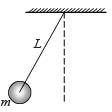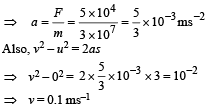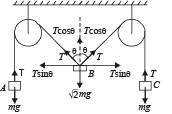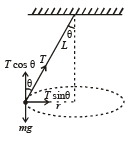JEE Advanced (Single Correct MCQs): Laws of Motion - JEE MCQ
16 Questions MCQ Test - JEE Advanced (Single Correct MCQs): Laws of Motion
A ship of mass 3 × 107 kg initially at rest, is pulled by a force of 5 × 104 N through a distance of 3m. Assuming that the resistance due to water is negligible, the speed of the ship is
A block of mass 0.1 kg is held against wall applying horizontal force of 5 N on the block .If coefficient of friction between the block and wallis 0.5 then tbe magnitude of frictional force acting on the block is ?
A block of mass 0.1 is held against a wall applying a horizontal force of 5 N on the block. If the coefficient of friction between the block and the wall is 0.5, the magnitude of the frictional force acting on the block is :
A small block is shot into each of the four tracks as shown below. Each of the tracks rises to the same height. The speed with which the block enters the track is the same in all cases. At the highest point of the track, the normal reaction is maximum in
An insect crawls up a hemispherical surface very slowly (see fig.). The coefficient of friction between the insect and the surface is 1/3. If the line joining the center of the hemispherical surface to the insect makes an angle a with the vertical, the maximum possible value of a is given by

The pulleys and strings shown in the figure are smooth and of negligible mass. For the system to remain in equilibrium, the angle θ should be

A string of negligible mass going over a clamped pulley of mass m supports a block of mass M as shown in the figure. The force on the pulley by the clamp is given by

What is the maximum value of the force F such that the block shown in the arrangement, does not move?

A block P of mass m is placed on a horizontal frictionless plane. A second block of same mass m is placed on it and is connected to a spring of spring constant k, the two blocks are pulled by distance A. Block Q oscillates without slipping.
What is the maximum value of frictional force between the two blocks.

The string between blocks of mass m and 2m is massless and inextensible. The system is suspended by a massless spring as shown. If the string is cut find the magnitudes of accelerations of mass 2m and m (immediately after cutting)

Two particles of mass m each are tied at the ends of a light string of length 2a. The whole system is kept on a frictionless horizontal surface with the string held tight so that each mass is at a distance 'a' from the centre P (as shown in the figure).
Now, the mid-point of the string is pulled vertically upwards with a small but constant force F. As a result, the particles move towards each other on the surface. The magnitude of acceleration, when the separation between them becomes 2x, is

A particle moves in the X-Y plane under the influence of a force such that its linear momentum is  where A and k are constants.
where A and k are constants.
The angle between the force and the momentum is
A block of base 10 cm × 10 cm and height 15 cm is kept on an inclined plane. The coefficient of friction between them is √3. The inclination θ of th is inclined plane from the horizontal plane is gradually increased from 0°. Then
A block of mass m is on an inclined plane of angle θ. The coefficient of friction between the block and the plane is m and tan θ > μ. The block is held stationary by applying a force P parallel to the plane. The direction of force pointing up the plane is taken to be positive. As P is varied from P1 = mg(sinθ – μ cosθ) to P2 = mg(sinθ + μ cosθ), the frictional force f versus P graph will look like
A ball of mass (m) 0.5 kg is attached to the end of a string having length (L) 0.5 m. The ball is rotated on a horizontal circular path about vertical axis. The maximum tension that the string can bear is 324 N. The maximum possible value of anguar velocity of ball (in radian/s) is

A car sometimes overturns while taking a turn. When it overturns, it is











 [∵ T = mg, (at equilibrium]
[∵ T = mg, (at equilibrium]


























